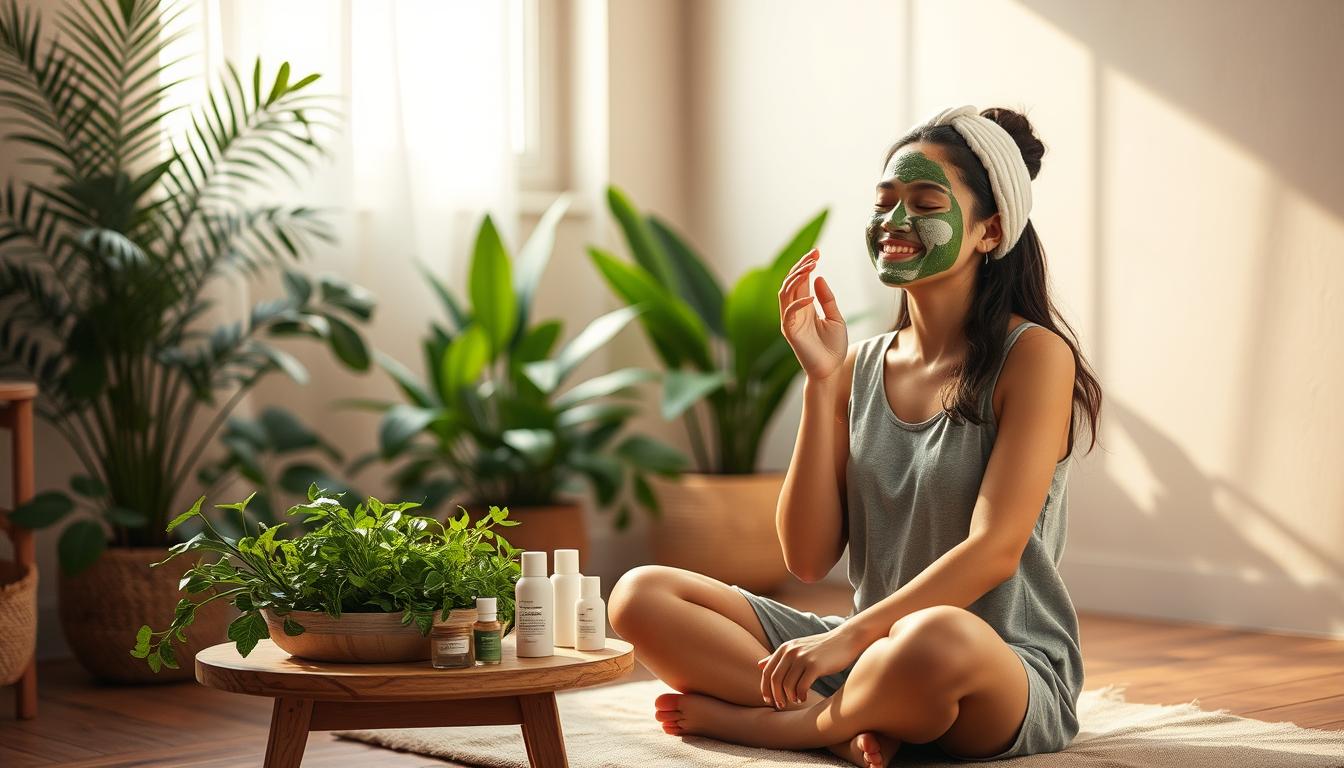How to Manage Ruddy Skin and Restore a Balanced Glow
Ever looked in the mirror and felt upset by facial redness? Ruddy skin is more than a cosmetic issue. It affects your confidence and comfort in your own skin.
Understanding ruddy skin is complex. It’s influenced by genetics, environment, and lifestyle. Your skin has a story to tell. Learning to listen can help restore its natural glow.
In this guide, we’ll dive into skin discoloration and offer practical tips. Whether you face occasional or chronic redness, you’ll find ways to change your skincare routine.
Table of Contents
Understanding Ruddy Skin and Its Causes
Ruddy skin can be a frustrating and complex condition that affects many people. Your complexion might appear persistently red or flushed. This is often linked to sensitive skin conditions like rosacea. Knowing the causes can help you find ways to manage and improve your skin’s appearance.
Many factors contribute to ruddy skin, making it a complex issue. These include genetic, environmental, and lifestyle factors. Let’s look at the main triggers that might be affecting your skin’s health and appearance.
Genetic Factors and Skin Sensitivity
Your genetic makeup plays a big role in skin sensitivity and ruddy complexion. Some people are more likely to have conditions like rosacea because of their genes. Certain genetic markers can make you more prone to:
- Increased skin inflammation
- Heightened blood vessel reactivity
- Reduced skin barrier function
- Higher sensitivity to environmental triggers
Environmental Triggers
External factors can greatly affect your skin’s appearance and sensitivity. Conditions that may lead to ruddy skin include:
| Environmental Factor | Impact on Skin |
|---|---|
| Extreme Temperatures | Causes blood vessel dilation and increased redness |
| UV Radiation | Triggers inflammation and weakens skin barrier |
| Air Pollution | Increases oxidative stress and skin irritation |
| Low Humidity | Reduces skin hydration and increases sensitivity |
Lifestyle Contributors
Your daily habits can greatly affect your skin’s appearance. Lifestyle factors that may worsen ruddy skin include:
- High stress levels
- Inadequate sleep
- Poor diet
- Excessive alcohol consumption
- Intense physical exercise
By understanding these causes, you can take steps to manage your skin’s sensitivity and reduce facial redness.
Signs of Facial Redness and Skin Irritation
Knowing the signs of facial redness helps you understand your skin better. A flushed face isn’t just about blushing. It can mean your skin is sensitive and needs care.
Look out for these signs of skin irritation:
- Persistent facial redness that doesn’t quickly fade
- Warm or burning sensation across cheeks and nose
- Visible blood vessels near the skin’s surface
- Dry, tight skin with uneven texture
- Increased sensitivity to skincare products
Different people show skin irritation in different ways. Some get a mild, temporary flush from exercise or heat. Others have chronic conditions like rosacea or eczema that cause lasting redness.
It’s important to know these signs. Skin irritation can come from many things, like the environment, genes, or lifestyle. By spotting your symptoms, you can start to fix your skin’s health.
The Role of Skin Barrier Function in Managing Ruddy Skin
Your skin barrier acts as a shield, keeping bad stuff out and good stuff in. For those with ruddy skin and sensitive skin, knowing about this shield is crucial. It can change how you get a balanced, healthy look.
The skin barrier is key in stopping irritation and keeping skin healthy. If it’s weak, you might see more redness, feel more sensitive, and get hit harder by the environment.
Signs of a Compromised Barrier
- Persistent redness and inflammation
- Increased skin sensitivity
- Dry, flaky patches
- Frequent breakouts
- Unusual itching or burning sensations
Steps to Restore Barrier Health
- Gentle Cleansing: Use mild, fragrance-free cleansers
- Hydrate with ceramide-rich moisturizers
- Avoid hot water and harsh exfoliants
- Use products with niacinamide and panthenol
Protective Measures
| Protection Strategy | Benefit for Ruddy Skin |
|---|---|
| Daily SPF Protection | Prevents further skin damage |
| Avoid Temperature Extremes | Reduces skin inflammation |
| Use Silk Pillowcases | Minimizes skin friction |
Understanding and protecting your skin barrier helps manage ruddy skin and lessens irritation. Being consistent is important for your skin’s health.
Essential Skincare Ingredients for Calming Redness
Dealing with rosy cheeks and facial redness can be tough. The right skincare can change how your skin looks and feel. Knowing which ingredients calm irritation is crucial for a balanced look.
Some ingredients are top choices for reducing redness and soothing sensitive skin. Here are the most effective ones for calming your skin:
- Niacinamide: Reduces redness and strengthens skin barrier function
- Centella Asiatica: Calms irritation and supports skin healing
- Green Tea Extract: Provides powerful anti-inflammatory protection
- Aloe Vera: Soothes and hydrates sensitive skin
- Panthenol: Helps repair and calm irritated skin
Choosing the right mix of anti-inflammatory ingredients can greatly help with rosy cheeks and facial redness.
| Ingredient | Primary Benefit | Best For |
|---|---|---|
| Niacinamide | Reduces inflammation | Sensitive and reactive skin |
| Centella Asiatica | Skin healing | Irritated and compromised skin barrier |
| Green Tea Extract | Antioxidant protection | Redness-prone skin |
Start with small amounts of these ingredients in your skincare routine. Always patch test to see how your skin reacts. Slowly adding them helps your skin adjust and avoid irritation.
Creating a Gentle Cleansing Routine
Managing ruddy skin needs a careful cleansing approach. Your skin’s sensitivity requires a gentle routine to avoid irritation. This helps your skin heal naturally.
Creating a proper cleansing routine is key for sensitive skin. The right steps can prevent stress and keep your skin healthy.
Morning Cleansing Protocol
Your morning routine should be light and refreshing. Follow these key steps:
- Use a lukewarm water splash to awaken your skin
- Select a mild, fragrance-free cleanser
- Gently pat skin dry with a soft, clean towel
- Avoid harsh rubbing that can trigger ruddy skin reactions
Evening Cleansing Steps
Evening cleansing needs extra care to remove daily impurities without harming your skin’s barrier:
- Remove makeup with a gentle, oil-based cleanser
- Use a non-foaming, hydrating facial wash
- Apply with fingertips using circular, soft motions
- Rinse thoroughly with cool water
Product Selection Guidelines
When choosing products for sensitive skin, look for these features:
- Hypoallergenic formulations
- Free from alcohol and harsh chemicals
- Contains soothing ingredients like chamomile or aloe vera
- pH-balanced to support skin’s natural protective barrier
Remember, everyone’s skin is different. What works for one might not work for another. Watch how your skin reacts and adjust your routine as needed.
Hydration Strategies for Balanced Skin

Managing ruddy skin needs a smart hydration plan. Keeping your skin’s moisture balance right is key to less facial redness and even skin tone. Learning how to hydrate right can change your skin from uneven and sore to smooth and bright.
Drinking water is just the start. Your skincare should also include special moisturizing steps for sensitive skin that gets red easily.
- Choose lightweight, non-comedogenic moisturizers
- Look for ingredients that support skin barrier function
- Avoid heavy, greasy products that can trigger inflammation
Some hydration ingredients are really helpful for ruddy skin:
| Ingredient | Benefit | Best For |
|---|---|---|
| Hyaluronic Acid | Deep hydration | Reducing skin sensitivity |
| Glycerin | Moisture retention | Improving skin tone evenness |
| Ceramides | Barrier repair | Calming facial redness |
Your hydration plan should be personalized. Watch how your skin reacts to different products and tweak as needed. Remember, steady, gentle hydration is essential for managing ruddy skin and getting a balanced, healthy look.
Anti-inflammatory Skincare Products and Applications
Managing ruddy skin needs a smart skincare plan. Your skin is sensitive, so it needs special care. The right products and how to use them can change your routine.
Choosing the right anti-inflammatory skincare is key. Look for ingredients that calm and protect your skin. They should help reduce inflammation and support your skin’s healing.
Natural Anti-inflammatory Options
Natural ingredients can help a lot with ruddy skin. Here are some top picks:
- Green tea extract: Reduces inflammation and fights free radicals
- Aloe vera: Cools and calms your skin
- Chamomile: Helps reduce skin irritation and redness
- Turmeric: Has natural anti-inflammatory and antioxidant benefits
Clinical-strength Solutions
For serious facial redness, you need strong treatments:
| Product Type | Key Benefits | Recommended For |
|---|---|---|
| Niacinamide Serums | Reduces inflammation, makes pores smaller | Sensitive and reactive skin |
| Ceramide Moisturizers | Fixes the skin barrier, lowers redness | Dry and damaged skin |
| Centella Asiatica Treatments | Speeds up healing, soothes irritation | Inflamed and stressed skin |
Everyone’s skin is different. Patch testing and talking to a dermatologist can guide you. They help find the best skincare for your skin’s needs.
Lifestyle Modifications for Skin Health

Managing ruddy skin is not just about creams and lotions. Your everyday choices are key to a healthy look. Stress, what you eat, how much you exercise, and sleep all affect your skin.
Stress can make your skin look flushed and worse. It makes your body release cortisol, which can harm your skin. Finding ways to relax can help your skin stay calm and less red.
- Practice daily meditation or deep breathing exercises
- Engage in regular physical activity
- Maintain a consistent sleep schedule
- Set boundaries to manage work and personal stress
Exercise is great for your skin. It boosts blood flow, gets rid of toxins, and helps new skin cells grow. Aim for 30 minutes of moderate exercise most days of the week. Pick activities you like, like walking, swimming, or yoga.
Good sleep is also vital for your skin. It helps your body fix and renew skin cells. Try to sleep 7-9 hours each night to help your skin heal and stay even-toned.
By changing your lifestyle, you can help your skin stay healthy and look better.
Diet and Nutrition Impact on Skin Tone Evenness
Your diet is key to managing ruddy skin and getting a balanced look. What you eat affects your skin’s health. It can help reduce facial redness and even out your skin tone.
Nutrition is a strong ally against rosy cheeks and for skin health. Eating the right foods can calm inflammation, help repair skin, and balance your complexion.
Essential Nutrients for Skin Health
- Omega-3 Fatty Acids: Reduce inflammation and support skin barrier function
- Vitamin C: Promotes collagen production and reduces skin redness
- Zinc: Helps heal skin and regulate oil production
- Antioxidants: Protect skin from environmental damage
Foods to Avoid
| Food Category | Potential Skin Impact |
|---|---|
| Refined Sugars | Increases inflammation, can trigger ruddy skin |
| Spicy Foods | May cause facial flushing and heightened skin sensitivity |
| Alcohol | Dilates blood vessels, potentially increasing skin redness |
| Processed Foods | Reduces skin’s natural healing capabilities |
By choosing your food wisely, you can help your skin stay balanced and reduce ruddy skin. Eat whole foods, stay hydrated, and focus on nutrients that are good for your skin.
Professional Treatments and When to Seek Help
Managing ruddy skin and facial redness can sometimes need professional help. If home treatments and skincare routines don’t help enough, it’s time to see a dermatologist. They know a lot about skin conditions like rosacea.
Professional treatments offer advanced solutions for ruddy skin and rosacea. These treatments can make your skin look better and reduce inflammation.
- Laser Therapy: Targets visible blood vessels and reduces facial redness
- Intense Pulsed Light (IPL) Treatments: Addresses uneven skin tone and redness
- Chemical Peels: Helps exfoliate and calm irritated skin
- Prescription Topical Medications: Reduces inflammation and manages symptoms
Knowing when to seek professional help is key. You should see a dermatologist if you have:
- Persistent facial redness lasting more than a few weeks
- Increased skin sensitivity or frequent flare-ups
- Visible blood vessels or bumps on your skin
- Significant discomfort or self-consciousness about your skin’s appearance
When choosing a dermatologist, look for board-certified specialists with experience in ruddy skin and rosacea. They can create a treatment plan just for you.
| Treatment Type | Primary Benefits | Average Cost Range |
|---|---|---|
| Laser Therapy | Reduces visible blood vessels | $300 – $1,500 per session |
| IPL Treatment | Improves skin tone and texture | $250 – $1,200 per session |
| Chemical Peels | Exfoliates and calms skin | $100 – $700 per treatment |
Remember, everyone’s skin is different. A professional can help you find the best way to manage ruddy skin and get your skin back to normal.
Conclusion
Managing ruddy skin is more than just treating the surface. It’s about understanding what makes your skin react, using gentle skincare, and making lifestyle changes. This guide has shown you how to improve your skin’s look and health.
Getting a balanced glow takes time and effort. It needs patience, regular care, and the right mix of skincare, nutrition, and protection. By tackling both inside and outside causes of redness, you can lessen inflammation and boost your skin’s defense.
Your skin can heal and change with the right care. Every step, from choosing soft cleansers to using anti-inflammatory products, moves you towards your goal. While everyone’s journey is different, the key is gentle care, staying hydrated, and focusing on overall health.
Believe in your skin’s ability to heal and change. With the right knowledge, dedication, and approach, you can manage ruddy skin. You’ll show off a bright, even-toned complexion that shows your health and confidence.



